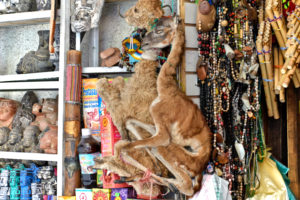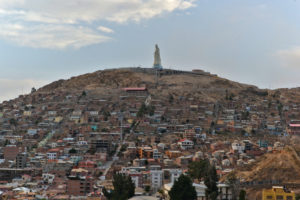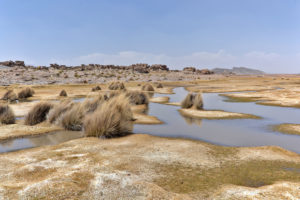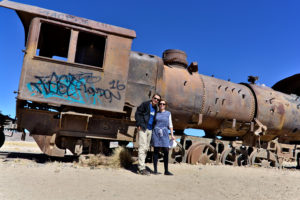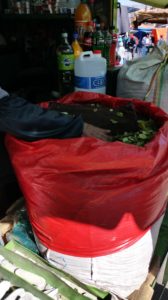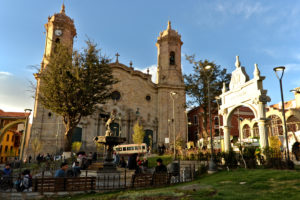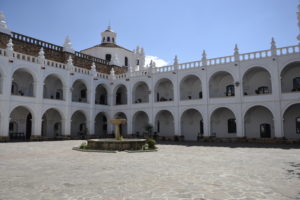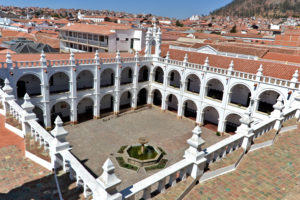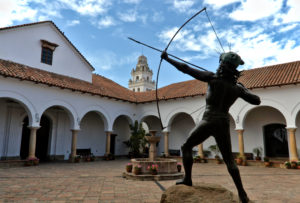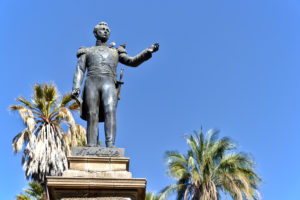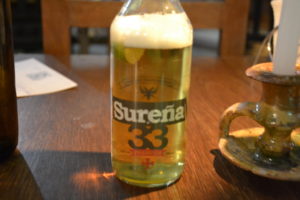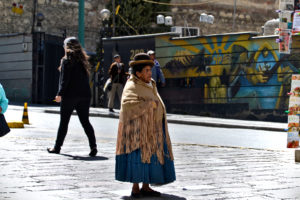
Bolivia Travel Tips
Bolivia is the highest and most isolated country in South America. It is a land of extremes with its 6,000m high Andean peaks, high-altitude and surreal (salt) desserts, mineral reaches and extreme poverty (approx. 50% of Bolivian live below the poverty threshold). However the spots we have seen were really amazing and worth a travel. Welcome to our travel guide for globetrotters & UNESCO enthusiasts – discover the top travel tips and oddities for Bolivia.
Content
Tips for planning your journey
Our route through Bolivia by rental car
Our Highlights in Bolivia
La Paz
Oruro
Poopo
Uyuni
Potosi (UNESCO World Heritage)
Sucre (UNESCO World Heritage)
Tiwanaku (UNESCO World Heritage)Our recommendations
If you want to read more about the country, we can recommend you some books
How to get there?
Since we have visited Bolivia on our all-around-the-world trip we flew from Lima to La Paz what is just a two hours flight. Travelling from Germany would mean a quite longer flight time with some stop-overs in Brasilia. Don’t fear in case you also have caught a late flight arriving at night at the airport El Alto in La Paz as we did. Since the airport is located in El Alto you do have to cross this area to get to your accommodation.
Our route through Bolivia
We have at the end stayed ten days in Bolivia. Initially, we have planned two complete weeks but to be able to include the Easter Islands into our itinerary we had to shorten our stay in Bolivia. Since we were not able to visit all UNESCO World Heritage sites we will likely be back once.

Our experience of self-driving in Bolivia
Self-driving in La Paz is sort of fun but some streets are that steep that our rental car couldn’t make them. Even though we had a small SUV. Traffic jams in the streets require a good relationship to the gas pedal.
Bolivia surprises us with good paved roads and few other cars outside the cities. Also the roads are quite straight – no up and downhill like in Peru. We have rented a four wheels vehicle but it seems also with a “normal” car we would have been able to travel here without limitations (maybe except for the salt desert in Uyuni). We drive on top of the mountains with very small towns along the road, many sheeps and alpacas. And from time to time desert and salty areas.
The costs for the rental car in Bolivia was one of the highest we had throughout our all-around-the-world trip. In addition, there are only few rental companies available that rent cars to foreigners. At the end we have chosen Europcar were we relied on an international assistance in case we would need it.
Our travel tips for Bolivia
La Paz
We arrived on September 10th in La Paz – the governmental city of Bolivia with altitudes from 4.100 m (especially the airport El Alto) to 3.200 m. We spent the first two days in the city center crossing different altitudes – several hundred meters in few hours. But it seems we are now acclimated since we did not face any issues with any of the altitudes (anymore).
La Paz is an urban jungle with lots of people (most of them of indigenous heritage) being on the streets but also with relaxed traffic (except for the mini buses). Never seen so many knotted electricity cables all over the streets. It is almost impossible to have pictures without these cables.
The city of La Paz around Rosario, Belen and San Pedro you can find several beautiful markets. Unbelievable but true, on the market (especially on the witch market) you can buy mummified alpaca babies like the Incas had as grave goods. North of the Plaza San Francisco you can find the main food plaza. We recommend to take a walk through the busy stalls. Unfortunately we weren’t brave enough to test the meals.
The church of San Francisco is located on the plaza of the same name. The original church collapsed around 1610 due to heavy snowfalls but it was reconstructed mid of the 18th century. In the garden of the church the stone faces represent Bolivia’s three great cultures: Tiwanaku, Inca and modern.
The cathedral is located in the eastern part of the city center on a steep hillside. The main entrance is 12 meters higher than its base. The dimension of the cathedral are impressive but even more are the stained-glass work inside.
Oruro
The direct route from la Paz to Uyuni is around 550 km. Therefore we have included Oruro in our itinerary that lies between these two cities. In case you like Carnival the best time to visit Oruro is in February. Since we were in Oruro in September we were walking around in the city center what was a quite calm area. Consequently, we also did not had any issues with finding a hotel at that time. We can definitively recommend the Hotel Virgin del Socavon as a modern hotel with rooms onto the Plaza del Folklore. Do not want to imagine the price of the rooms during Carnival season.
Poopo
We stopped at an industrial site in Poopo that is without any detour on the way from Oruro to Uyuni. It is a nice stop to have authentic views from the outside to former mining buildings and the Andean life.
Impressions from driving on the State Street number 1
Credit Card Hacking
Amazing what we have bought within one day: Netflix account, surgeries in a Canadian hospital, PayPal transactions in UK, etc. 30 transactions in one day from our credit card. Suspicious… And therefore, the bank locked our credit card. This means one out of our five credit cards is blocked after seven weeks of our tour. When we continue in this frequency we will return home without any credit card remaining. So still sufficient. 🙂
Uyuni
Uyuni itself is a very touristic place that reminded us of Aqua caliente submontane Machu Picchu. It was hard to find anything else for dinner except pizza and noodles. Don’t forget that the nights are getting very cold in this area. We have booked a hotel room without any heating. Luckily we had our small water cattle with us so that we enjoyed a lot of warm tea in the evening.
We decided not to do an organized tour through the Salar de Uyuni but were using our rental car to explore the area. It is helpful to use a navigation system or in our case our very much valued Garmin eTrex that was recording our route inside the Salt Lake.
Train cemetery
Besides the popular salt lake, there is a train cemetery in Uyuni where a very large number of historic steam locomotives are rusting away in the desert. Some of them are around 100 years old. Unfortunately there is no museum for them. And therefore, pieces from the locomotives have been taken away and used for furniture in bars around Uyuni or for statues in the city center. It is really fun climbing up the trains and walking through this outside free admission museum.
Salt Lake
The salt lake or nowadays salt desert near Uyuni is the world’s largest one with approx. 10,000 km². The complete area on 3,650 m above sea level is covered with salt and looks like snow with an interesting structure. Distances are not recognizable due to the overall white area which leads to curious and very popular photos. Consequently, we made 421 photos on a single day…
The Salar de Uyuni is now a center of salt extraction and processing. Beside the thousands of tons of output lithium deposits are beneath the massive surface. This site is drained internally since there is no outlet to the sea. The salt deposits are the result of the minerals leached from the mountains and deposited at the lowest available point. Uyuni is definitely one of our top travel tips for Bolivia
Potosi (UNESCO World Heritage)
Potosi is the city which is strongly connected to its silver mine in the mountain “Cerro Rico” (rich mountain). It was founded in 1545 after the silver has been detected and was at that time the largest and wealthiest city of Americas and even bigger than Paris or London. Today it is the highest city in the world on the altitude of 4.100 m. The silver was mainly used by the Spanish to produce coins.
What we have seen is rather a decline of the city and the poverty. But still a lot of miners are extracting minerals from the mine. On a market, the miners have to buy all the things themselves they need – from coca leaves, alcohol (95%) to dynamite. No one is certain how much silver has been extracted from this rich mountain but experts estimate that a silver bridge could have been constructed to Spain and still silver would have been left over to carry on it.
Potosi is recognized by the UNESCO as a World Heritage due to the industrial monuments of the Cerro Rico and the authentic colonial town with the houses the workers used to live. The site is on the list of World Heritages in danger due to the vulnerability and risk of collapse of Cerro Rico.
Our travel book recommended a visit in the cooperative mines that will create most memorable experiences of Bolivia. However, watching some videos from the tours and read about the risks according to the hit-and-miss principle since work is still going on in the mine. But the city definitely counts to our top Bolivia travel tips.
Sucre (UNESCO World Heritage)
The next stop on our tour was the capital city Sucre. This is the city which is most European in Bolivia. For us, this was the most beautiful city in Bolivia and is in competition with Cusco and Cuenca as the most beautiful cities yet on our tour. Although the seat of the government is in La Paz, Sucre is recognized as the nation’s capital. Sucre is also called the “white city” and preserves a wealth of colonial architecture.
Recommended sights
The beautiful houses with the pretty patios invite for extensive walks in the city center without loosing the desire to explore more. The stringent controls on development have helped Sucre to preserve the authenticity of the city and lead to the inscription to the UNESCO World Heritage List. For an insight into Bolivian history you should visit the place that is considered as the birthplace of the nation (Casa de la Libertad). For the best view in town climb up the cupula at the national police office inside the Prefectura de Chuquisaca (State Government Building) next to the cathedral.
Kultur Café Berlin
Greetings to my friends in Berlin – we tasted some local beers in the pub “Kultur Cafe Berlin”.
Market
For curiosity we visited the local food market that is popular for the freshness of fruits, juices and sweets.
Cementerio Municipal
The cemetery just lies a short walk outside form the city center to visit the graves and mausoleums from the wealthy people.
Tiwanaku, Titicaca (UNESCO World Heritage)
For two days we traveled 750 km back from Sucre to Tiwanaku (with again a stop-over in Oruro) near lake Titicaca. Not much is known about the people who constructed their ceremonial center here more than a thousand years ago. Only around 30% of the archeologically site is visible today and digging is going on. From a historic point of view this site is very important and therefore inscribed to UNESCO World Heritage list but from what you can see, it cannot beat Machu Picchu.
El Alto in La Paz
With the following impressions from Bolivian life (pictures taken in El Alto – a part of La Paz where also the airport is located) we are leaving Bolivia and continue our trip to Chile.
Our recommendations for Bolivia
For Bolivia we have used the Lonely Planet Travel book for Bolivia. In addition since we were visiting Bolivia on our all around the world trip we were also using for moving around and more tips the greater Lonely Planet for South America.
During our All-Around-the-World trip and the time we spent in South America, we have read the following books what we would like to recommend to you since we enjoyed reading the travel stories and recalled some of the places and the relating story during our visit. We also recommend a collection of short stories illustrating the life in Bolivia and oddities in the infamous La Paz prison:














